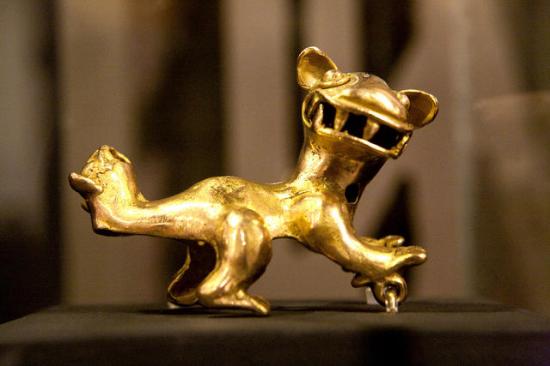Wildcats take center stage in pre-Columbian artifact exhibit
Dominique Farrell
Source - http://www.ticotimes.net/Weekend/Arts-Leisure/Wildcats-take-center-stage-in-pre-Columbian-artifact-exhibit_Friday-December-16-2011
A new exhibit at the Central Bank Museums explores “Felines in Costa Rican Archaeology: Past and Present.”

Jessica Phelps - A gold representation of a puma is among 50 pre-Columbian artifacts now on display as part of the “Felines in Costa Rican Archaeology” exhibit at the Central Bank Museums in downtown San José.
The six species of wildcats native to Costa Rica have pounced into a new exhibit at the Pre-Columbian Gold Museum, part of the Central Bank Museums in San José.
“Felines in Costa Rican Archaeology: Past and Present” consists of 50 stone, gold or ceramic artifacts dating from 300 B.C. to A.D. 1500, depicting the jaguar, ocelot, tiger cat, margay, puma and jaguarundi.
The pieces, on loan from the Central Bank, National Museum and Jade Museum, were found all over Costa Rica.
“Cats were part of the symbolism expressed by ancient peoples, whether for their habits and skills or their physical characteristics,” said Patricia Fernández, the museum’s archaeological curator. “Attributes such as their strength, agility and ferocity were added to human figures in the form of feline faces and spotted skin.”
The artifacts display styles and techniques from different regions and from various time periods. Some of the representations are stylized and others realistic, Fernández explained.
The exhibit also features a video titled “Cruzada Jaguar” (“Jaguar Crusade”), which includes an interactive game and information on conservation efforts.
Fernández said visitors can learn about the origin of the different species and the danger of extinction they all face.
“We are at risk of losing them,” Fernández said. “If we do not reverse the process, we will know them as museum pieces only.”
The main threat to Costa Rica’s wildcats is deforestation, Fernández said. Hunting for sport is another danger, though not as prevalent as in the past, she added.
While biological corridors have been set
up in the country to protect these cats, Fernández hopes the exhibit will raise public awareness about their plight.
Biologists and wildcat experts Eduardo Carrillo of the National University and Gustavo Gutiérrez of the University of Costa Rica collaborated on researching and identifying the archaeological materials. The two worked with archaeologist Fernández to develop an informational publication to accompany the exhibit.
“Felines in Costa Rican Archaeology” will run until October 2012 : www.museosdelbancocentral.org.